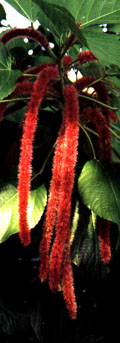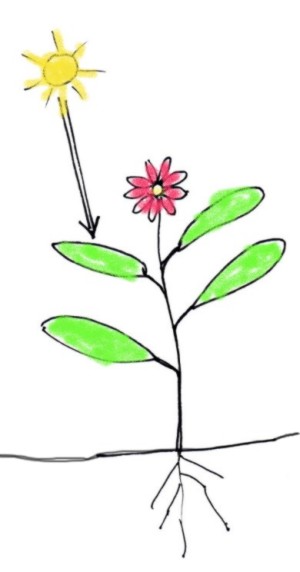 |
From the Ground Up
Many, perhaps most, of the visitors to this site will find this series too elementary to be worth reading. Please don't dismiss it too quickly, though - I often find some new idea, or way of thinking about something, in the simplest sounding articles.
|
||
|
|
Do you have drawings posted on your refrigerator? If not, do you remember them? Stick figures of people, houses with two or four windows and a door, and smoke coming out of the chimney. What about the plants?
Very easy to understand, though. In our stick picture we see the leaves receiving sunlight. They use this energy to produce simple sugars in the process called photosynthesis. These simple sugars can be used by the plant to release the energy stored in them to fuel all of the plant's activities. They can be carried round to all parts of the plant, and used wherever they are needed, and they may themselves be the basis for any of the far more complex compounds that are used by the plant to build itself, or to control all of its activities. The stem of the plant holds the leaves in the best position possible for the leaves (the photosynthetic factories) to receive energy from the sunlight. It is also a transport area-may I use a plumbing analogy- the main stack that moves things around the plant. One part of the plumbing carries the products of the leaf activity away from the leaves, and another, separate but parallel, system carries everything from the roots up to the leaves and other parts of the plant. This brings us to the roots, which are the physical connection to the ground that holds the trunk upright, but which also are in intimate contact with everything that is going on in the soil. Most of the water, and most of the chemicals that the plant uses to make its complex materials, enter the plant through the roots. So here is the system: the roots hold the plant in place and take up the water and nutrients that the plant needs; the stem or trunk carries these around the plant and also pushes the leaves up to where they can perform their job; this job is to convert energy received from the sun into a transportable, storable, chemical form that is the fuel for everything that the plant does. See why it is fair to regard the plant as a system which only works if each part of it is working properly? Oh, I almost forgot the flower. this is the part that must do whatever it takes to make seed, and then to spread these seed around to make more individuals of the plant. A series of whole complex stories there. Let me leave this with the thought that to a seed, everything the plant does is just a way of producing more seed like itself. |
||
